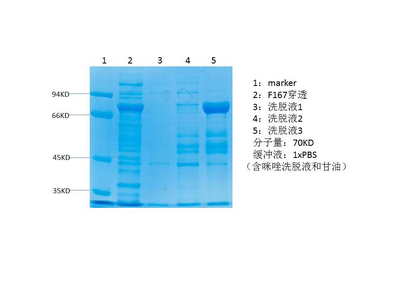- 首页
- 公司介绍
- 热门促销
-
全部产品
-
试剂盒
- |
-
一抗
- |
-
二抗
- |
-
蛋白
- |
-
免疫组化试剂
- |
-
WB 试剂
- PonceauS Staining Solution
- PBST Washing Buffer, 10X
- 1.5M Tris-HCl Buffer, pH8.8
- 1M Tris-HCl Buffer, pH6.8
- 10% SDS Solution
- Prestained Protein Marker
- TBST Washing Buffer, 10X
- SDS PAGE Loading Buffer, 5X
- Stripping Buffered Solution
- Tris Buffer, pH7.4, 10X
- Total Protein Extraction Kit
- Running Buffer, 10X
- Transfer Buffer, 10X
- 30% Acr-Bis(29:1) Solution
- Tris电泳液速溶颗粒
- PBS(1X, premixed powder)
- TBS(1X, premixed powder)
- 快速封闭液
- 转膜液速溶颗粒
- Chemical reagents
- 公司新闻
- 营销网络
- 资源中心
- 联系我们
HSPB8 protein
- 货号:YD0049
- 应用:WB;SDS-PAGE
- 种属:Human
- 序列:
- Amino acid: 1-145+170-196, with his-MBP tag.
- 储存:
- -20°C/6 month,-80°C for long storage
- 其他名称:
- Heat shock protein beta-8 (HspB8) (Alpha-crystallin C chain) (E2-induced gene 1 protein) (Protein kinase H11) (Small stress protein-like protein HSP22)
- 背景:
- caution:Was reported (PubMed:10833516) to have a protein kinase activity and to act as a Mn(2+)-dependent serine-threonine-specific protein kinase.,disease:Defects in HSPB8 are the cause of Charcot-Marie-Tooth disease type 2L (CMT2L) [MIM:608673]. CMT2L is an axonal form of Charcot-Marie-Tooth disease. Axonal CMT neuropathies are characterized by signs of axonal regeneration in the absence of obvious myelin alterations, normal or slightly reduced nerve conduction velocities, and progressive distal muscle weakness and atrophy.,disease:Defects in HSPB8 are the cause of distal hereditary motor neuronopathy type 2A (HMN2A) [MIM:158590]; also known as distal hereditary motor neuropathy type IIA or spinal Charcot-Marie-Tooth disease IIA. Distal hereditary motor neuronopathies constitute a heterogeneous group of neuromuscular disorders caused by selective impairment of motor neurons in the anterior horn of the spinal cord, without sensory deficit in the posterior horn. The overall clinical picture consists of a classical distal muscular atrophy syndrome in the legs without clinical sensory loss. The disease starts with weakness and wasting of distal muscles of the anterior tibial and peroneal compartments of the legs. Later on, weakness and atrophy may expand to the proximal muscles of the lower limbs and/or to the distal upper limbs.,function:Displays temperature-dependent chaperone activity.,induction:By 17-beta-estradiol.,PTM:Phosphorylated.,similarity:Belongs to the small heat shock protein (HSP20) family.,subunit:Monomer. Interacts with HSPB1.,tissue specificity:Predominantly expressed in skeletal muscle and heart.,
- 功能:
- cell death, response to temperature stimulus, response to heat, response to abiotic stimulus, death,
- 细胞定位:
- Cytoplasm . Nucleus . Translocates to nuclear foci during heat shock.
- 组织表达:
- Predominantly expressed in skeletal muscle and heart.




